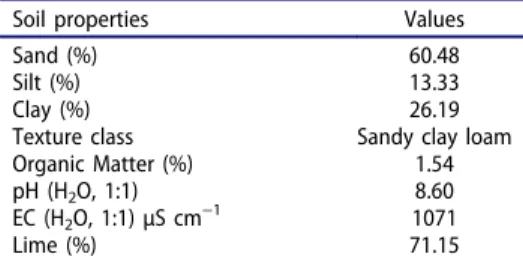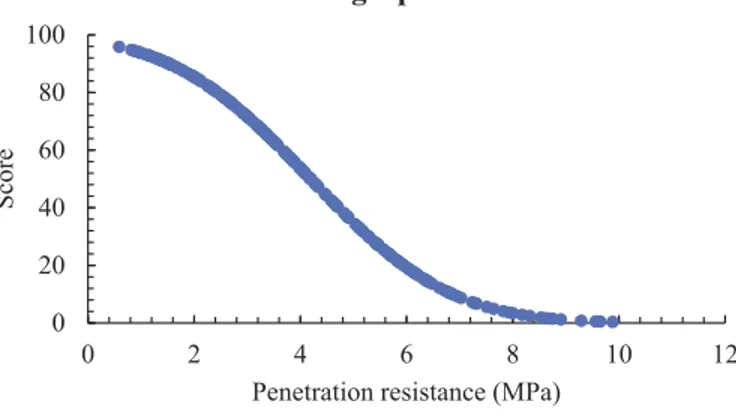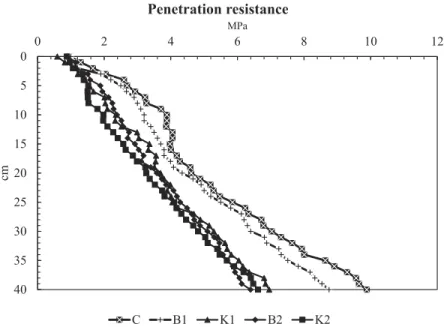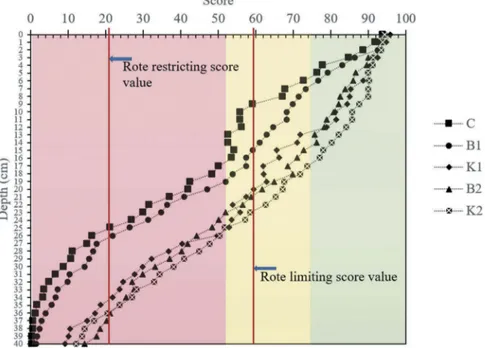Full Terms & Conditions of access and use can be found at
https://www.tandfonline.com/action/journalInformation?journalCode=lcss20
Communications in Soil Science and Plant Analysis
ISSN: 0010-3624 (Print) 1532-2416 (Online) Journal homepage: https://www.tandfonline.com/loi/lcss20
Effects of Biochar and Compost Applications on
Penetration Resistance and Physical Quality of a
Sandy Clay Loam Soil
Hamza Negiş, Cevdet Şeker, Ilknur Gümüş, Noel Manirakiza & Osman
Mücevher
To cite this article: Hamza Negiş, Cevdet Şeker, Ilknur Gümüş, Noel Manirakiza & Osman Mücevher (2020) Effects of Biochar and Compost Applications on Penetration Resistance and Physical Quality of a Sandy Clay Loam Soil, Communications in Soil Science and Plant Analysis, 51:1, 38-44, DOI: 10.1080/00103624.2019.1695819
To link to this article: https://doi.org/10.1080/00103624.2019.1695819
Published online: 26 Nov 2019.
Submit your article to this journal
Article views: 250
View related articles
View Crossmark data
ARTICLE
Effects of Biochar and Compost Applications on Penetration
Resistance and Physical Quality of a Sandy Clay Loam Soil
Hamza Negiş a, CevdetŞekera, Ilknur Gümüşa, Noel Manirakizaa, and Osman Mücevherb
aDepartment of Soil Science and Plant Nutrition, Faculty of Agriculture, Selcuk University, Konya, Turkey;bSoil, Water
and Deserting Control Research Institute, Konya, Turkey
ABSTRACT
Due to intensified agricultural mechanization, soils are exposed to increased levels of degradation. Soil compaction is the beginning of this degradation which further proceeds to decrease organic matter content of soils. Among the various methods applied to solve these problems, the addition of organic matter to the soil has an important place. Thus, agricultural land application of organic wastes, such as biochar and compost, could alter the soil properties to offset the degradation effects. The aim of this research was to determine the effect of compost and biochar application on the soil compaction and its quality score. Biochar and compost of the Elaeagnus tree pruning residues were applied in a field at a similar rate of 0%, 2%, and 4%. Results indicated that the soil penetration resistance (PR) statistically experienced a downward trend compared to the control when applied with compost and biochar. The application of 2–4% biochar and compost low-ered soil PR by exactly 8.80%, 9.33%, 18.22%, and 28.89%, respectively, throughout the period of 7 months. Furthermore, the infusion of biochar and compost into the soil significantly increased the soil compaction quality score compared to the control, and the least value of PR was observed for the compost-treated soil at the application rate of 4%. Compost and biochar applications were effective to improve the physical quality of a sandy clay loam soil, making it more suitable for plant development. On the other hand, the effect of compost treatments was more impact than biochar treatments.
ARTICLE HISTORY
Received 26 November 2018 Accepted 4 November 2019
KEYWORDS
Biochar; compost; Elaeagnus tree; penetration resistance; soil compaction
Introduction
The proliferation of agricultural mechanization and excessive agricultural activities results in apply-ing more pressure on the soils. Increased pressure application is detrimental to the soil quality, thereby adversely affecting fertility and sustainable use of soils. The increase of soil bulk density, penetration resistance (PR) and decrease of water and air permeability by depending on the applied pressure and soil properties weaken the plant root development, and subsequently this is accom-panying with chemical, physical and biological degradation within the soil (Agegnehu et al. 2015; Greenland1981; Guimarães et al.2013; Riahi et al.2018).
Physical degradation occurring in the soils change by depending mainly on soil tillage, seedbed preparation, sowing, maintenance, and harvesting activities. Especially, excessive soil tillage with unsuitable equipment is the leading reason for soil physical degradation under unfavorable condi-tions (Arvidsson 2001; Arvidsson, Sjöberg, and van den Akker 2003). The degradation of soil structure plunge in aggregate stability, porosity, soil aeration and water permeability, increase of PR, and soil crusting formation at the surface are the leading indicators of physical quality
CONTACTHamza Negiş hnegis@selcuk.edu.tr Department of Soil Science and Plant Nutrition, Faculty of Agriculture, Selcuk University, Konya, Turkey
Color versions of one or more of the figures in the article can be found online atwww.tandfonline.com/lcss. © 2019 Taylor & Francis Group, LLC
2020, VOL. 51, NO. 1, 38–44
degradation (Özdemir and Canbolat1997; Servadio et al.2005). Soil bulk density increases with an increase in soil compaction (Gomez et al. 2002), and a decrease in porosity, O2 diffusion, and
microbial activities (Addiscott and Dexter1994; Dexter1997; Hamza and Anderson2005; Renault and Sierra1994).
Compost, which originates from the decomposition of plant material or organic wastes, is considered as amid fertilizer (Aggelides and Londra 2000). The application of composted organic bio-wastes as organic fertilizers is still popular, and agricultural use of compost is found to have a definite advantage to the soil quality improvement. The infusion of compost into the soil scale up soil plant nutrient and organic matter, thereby positively affecting soil physical, chemical and biological properties (Hargreaves, Adl, and Warman 2008). In recent years, biochar, which is a solid product of biomass pyrolysis, is considered an evidenced soil amendment because it is attributed to soil carbon pool and can remain intact in the soil. Biochar, which is recognized as a valuable soil ameliorant, can offset the effects of climate change because it has a definite capability of retaining too much carbon (Peake, Freddo, and Reid2014). An ample number of evidence shows that it affects soil physical, chemical and biological properties by acting as soil amendment (Glab et al. 2018; Lehmann et al. 2011; Li et al. 2018; Mukherjee and Lal 2013; Wang et al. 2018). Furthermore, the effects of biochar application on other soil physical properties, such as PR, hydraulic conductivity, bulk density, and soil structure have not been fully evaluated in the field conditions (Asai et al.2009; Busscher et al.2010; Chan et al.2007; Glaser, Lehmann, and Zech2002; Laird et al.2010; Masulili, Utomo, and Syechfani2010; Peng et al.2011).
In this study, we hypothesized that the concurrent application of oleaster’s compost and biochar influences the soil compaction, yet this influence can be modified by adjusting compost components and application rates. The objective of this study was to determine the effect of different compost and biochar rates on compaction characteristics of sandy soil.
Materials and methods Sample preparation
The field study was conducted at Soil, Water and Deserting Control Research Institute in Karapınar, Konya province, and the general soil properties of the study area are given in Table 1. The experimental design had the following five compost and biochar treatments with three replications: Control (C), %2 Compost (K1), %4 Compost (K2), %2 Biochar (B1), %4 Biochar (B2). Thus, there were 15 experimental plots, each having an area of 15 m2with dimensions 3 m x 5 m. The compost and biochar were evenly mixed at 0–20 cm depth into the prepared soil prior to planting.
Measurements
Soil PR, which is an indication of soil compaction, was determined to the depth of 40 cm by a hand-pushing digital cone penetrometer using a cone having 1 cm2 base area, 60° included angle, and
Table 1.Some soil physical and chemical properties of the study area.
Soil properties Values
Sand (%) 60.48
Silt (%) 13.33
Clay (%) 26.19
Texture class Sandy clay loam
Organic Matter (%) 1.54
pH (H2O, 1:1) 8.60
EC (H2O, 1:1) µS cm−1 1071
Lime (%) 71.15
80 cm driving shaft, and readings were recorded at 1 cm intervals. The plots were irrigated with drip irrigation 2 days prior to the measurements which were made at 5 points in each plot in June. The soil sample was collected for moisture determination, at 3 points of each plot.
Moisture correction of the measured penetration resistance
The most important factor affecting penetration resistance values is soil moisture content (Seker
1999), and in order to compare the measured penetration values with each other, they must have the same moisture. The following equation form Busscher and Bauer (2003), was used to compare the penetration data of the soils with different moisture content during measurement.
Yc= Yoexp((X– 0.1)/0.132)
Yc= Corrected penetrometer reading (MPa)
Yo= Measured penetration resistance reading (MPa)
X = Moisture content at the measurement (kg kg−1)
0.1 = Coefficient used to calibrate penetration resistance values to 10% moisture content
Soil penetration resistance scoring
Scoring is the most up-to-date procedure for the soil healthy control and comparison of the processes applied to soils for many years. Therefore, the conversion of measured penetration data to score was achieved by modifying soil quality test scoring data (Gugino et al. 2009). As it is presented inFigure 1, scoring was done by using a steady decreased scoring curve in the 0–40 cm
depth of the applications.
Statistical analysis
Using the statistical software package SPSS 22.0 (SPSS Inc., Chicago IL), the analysis of variance was performed to evaluate the significance of the penetration resistance of the soil. Means were compared using a Tukey test with a level of significance of P < .05.
Results and discussion Penetration resistance
Based on the observation of the data presented inTable 2, the measured PR values at 0–10 cm depth
statistically were found to be significant (P < .05), and were certainly 2.57 MPa, 2.34 MPa, 1.54 MPa, 1.74
0 20 40 60 80 100 0 2 4 6 8 10 12 Score
Penetration resistance (MPa)
Score graphic
MPa, and 1.41 MPa for C, 2% biochar, 2% compost, 4% biochar, 4% compost application, respectively (Table 2). The observed PR measured at 11–20, 21–30 ve 31–40 cm depth was higher in the control
treatment than others with 4.15, 5.98 ve 8.68 MPa, respectively (Table 2; Figure 2). Infusion of both compost and biochar into the soil experienced a downward trend of PR in all soil depth (P < .05), the least PR value in all soil depth was found in the 4% compost-treated soil (P < .05;Table 2). The results of the study showed that an increase in the application rates was associated with a decrease in PR value, and however, only PR value of 2% compost-treated soil was lower than 4% biochar treated one at 0–10 cm depth. Effect of compaction as a limiting factor for crop root development at 0–10 and 11–20 cm depth in all plots was absent. Yet, limiting factor for crop root development of more than 4 MPa was found in all treatment at 21–30 cm depth except 4% compost-treated soil (Graecen, Barley, and Farrell1969). As shown inTable 2, the observed PR value at 31–40 cm depth indicated that all treatment experienced
limiting factor for crop root development of more than 6 MPa exclusive of 4% compost and biochar application. Biochar and compost can effectively decrease soil PR, and this has been shown in a wide diversity of agricultural soils of different textures (Li et al.2018). The evidenced study revealed that the microbial activities, nutrient uptake, and water retention are affected by depending on the soil compac-tion and fluctuacompac-tion of the soil–air and soil–water interaccompac-tion (Martıınez and Zinck2004). According to the reported findings of different researches indicated that increased organic matter content results in decreasing soil PR (Alameda, Villar, and Iriondo2012; Celik et al.2010; Iqbal2018). The application of Table 2.Comparison of measured penetration values at different depths (n = 15) with respect to treatment.
Treatment C B1 K1 B2 K2
Depth (cm) Penetration resistance (MPa)*
0–10 2.57 ± 0.97a 2.34 ± 0.58ab 1.54 ± 0.56c 1.74 ± 0.52bc 1.41 ± 0.34c
11–20 4.15 ± 0.27a 3.59 ± 0.43b 3.19 ± 0.46bc 2.98 ± 0.35cd 2.63 ± 0.45d
21–30 5.98 ± 0.75a 5.78 ± 0.58a 4.40 ± 0.56b 4.39 ± 0.44b 4.10 ± 0.49b
31–40 8.68 ± 0.92a 7.74 ± 0.69b 6.17 ± 0.55c 5.78 ± 0.35c 5.82 ± 0.58c
*The lowercase letters in the table show the significant difference between the different treatments in each row.P < 0.05. C: Control, B1: 2% Biochar, K1: 2% Compost, B2: 4% Biochar, K2: 4% Compost.
0 5 10 15 20 25 30 35 40 0 2 4 6 8 10 12 cm MPa Penetration resistance C B1 K1 B2 K2
Figure 2.Effects of amendment on soil penetration resistance at 0–40 cm soil depth (C: Control, B1: 2% Biochar, K1: 2% Compost, B2: 4% Biochar, K2: 4% Compost).
compost and biochar at 0–20 cm soil depth with increasing doses decreased PR value by exactly 9.07% and 28.34%, respectively, and with similar application, PR value decreased by certainly 30.40% and 34.70%, respectively, at 0–40 cm depth compared to the control (Table 2). Water storage and movement within the soil is fairly important in terms of crop development under the arid and semi-arid climatic regions. The water infiltration and movement into the soil are directly hampered by soil compaction, thereby causing drought stresses in the aforementioned region. Therefore, increasing and maintaining the soil organic matter content especially by improving directly soil physical properties affects other soil properties in the climatic zones with low precipitation.
Scoring
Scoring, grading, and classification of soil properties substantially enable easier comparison of the studied soils over many years and a more comprehensive comparison of regional studies and scoring study has become increasingly popular nowadays. The comparison and interpretation of the raw data under one value is easier and more understandable. The measured penetration values, which were converted to score, are given in Figure 3. Scores were made in every 1 cm to better compare the applications. The observed score values in the C plot up to 6 cm were found to be high, and similarly, this value for B1, K1, B2 and K2 plots at 11, 15, 16 and 18 cm depth was increased (Figure 3). The evidenced study done by Gugino et al. (2009) showed that penetration resistance values found in C, B1, K1, B2, and K2 at 12, 17, 23, 22, and 24 cm soil depth, respectively, were lower and experienced lower scores depending on grading, and after this soil depth, scoring reached to the lower-class level. The observed average score value’s calculations at 0–40 cm were 38, 43, 56, 58, and 61 (Figure 3), and based on this aforementioned calculation, it was found that scoring values varied from 13.15% to 60.52%. Based on the observation of scoring value, the highest scoring value was recorded for 4% compost-treated plot.
Figure 2depicts that the limits that the practices value the root development and the limits of root development are changed. When the penetration resistance was above 4≥ MPa (score value: 49), it was
Figure 3.Score value of penetration resistance at different soil depth with respect to the applied amendment. C: Control, B1: 2% Biochar, K1: 2% Compost, B2: 4% Biochar, K2: 4% Compost.
reported that the root development was restricted, and when root growth was over 6.0 MPa (score value: 20), the root growth was completely stopped. When the root growth is restricted or completely stopped, the plant cannot benefit from exchangeable plant nutrients and available water. When the applications are examined, it is seen that the limiting depth of the root development is differentiated by the applications. When the C, B1, K1, B2, and B4 parcels are examined, the soil depth values where the root limit values are reached are 9, 17, 22, 23, and 25 cm, respectively (Figure 3). Compared to the soil depths (≤20) where the root growth has stopped completely, it is observed that the limit value has come 25, 27, 35, 35, and 38 cm, respectively.Figure 3shows the effect of materials mixed to 0–20 cm to
the depth of the lower soil. During the period of plant development, it was ensured that the field traffic is not transmitted mechanically to the lower soil layer due to the increase in the carrying capacity of the upper soil layer and therefore the nutrients and water required for the healthy development of the plants can be used by taking more space.
Conclusions
The penetration resistance properties in the soils affect the plant growth by directly or indirectly affecting retention, movement, and usability of soil nutrients as well as soil microbial activity. Evenly mixing of organic matter with the soil fraction results in decreasing soil penetration resistance value. It was found that the infusion of organic matter into the soil up to 0–20 cm depth significantly facilitates easily soil tillage and decrease soil compaction in the upper part of the soil profile, thereby enhancing agricultural production.
ORCID
Hamza Negiş http://orcid.org/0000-0002-1880-9188
References
Addiscott, T. M., and A. R. Dexter.1994. Tillage and crop residue management effects on losses of chemicals from soils. Soil & Tillage Research 30:125–68. doi:10.1016/0167-1987(94)90003-5.
Agegnehu, G., A. M. Bass, P. N. Nelson, B. Muirhead, G. Wright, and M. I. Bird.2015. Biochar and biochar-compost as soil amendments: Effects on peanut yield, soil properties and greenhouse gas emissions in tropical North Queensland, Australia. Agriculture, Ecosystems & Environment 213:72–85. doi:10.1016/j.agee.2015.07.027. Aggelides, S. M., and P. A. Londra.2000. Effects of compost produced from town wastes and sewage sludge on the
physical properties of a loamy and a clay soil. Bioresource Technology 71:253–59. doi:10.1016/S0960-8524(99)00074-7. Alameda, D., R. Villar, and J. M. Iriondo.2012. Spatial pattern of soil compaction: Trees’ footprint on soil physical
properties. Forest Ecology and Management 283:128–37. doi:10.1016/j.foreco.2012.07.018.
Arvidsson, J.2001. Subsoil compaction caused by heavy sugarbeet harvesters in southern Sweden: I. Soil physical properties and crop yield in six field experiments. Soil & Tillage Research 60:67–78. doi:10.1016/S0167-1987(01)00169-6. Arvidsson, J., E. Sjöberg, and J. J. H. van den Akker.2003. Subsoil compaction by heavy sugarbeet harvesters in
southern Sweden: III. Risk assessment using a soil water model. Soil & Tillage Research 73:77–87. doi:10.1016/
S0167-1987(03)00101-6.
Asai, H., B. K. Samson, H. M. Stephan, K. Songyikhangsuthor, K. Homma, Y. Kiyono, Y. Inoue, T. Shiraiwa, and T. Horie. 2009. Biochar amendment techniques for upland rice production in Northern Laos: 1. Soil physical properties, leaf SPAD and grain yield. Field Crops Research 111:81–84. doi:10.1016/j.fcr.2008.10.008.
Busscher, W. J., and P. J. Bauer.2003. Soil strength, cotton root growth and lint yield in a southeastern USA coastal loamy sand. Soil & Tillage Research 74:151–59. doi:10.1016/j.still.2003.06.002.
Busscher, W. J., J. M. Novak, D. E. Evans, D. W. Watts, M. A. S. Niandou, and M. Ahmedna.2010. Influence of pecan biochar on physical properties of a norfolk loamy sand. Soil Science 175:10–14. doi:10.1097/SS.0b013e3181cb7f46. Celik, I., H. Gunal, M. Budak, and C. Akpinar.2010. Effects of long-term organic and mineral fertilizers on bulk density and penetration resistance in semi-arid Mediterranean soil conditions. Geoderma 160:236–43. doi:10.1016/j.
geoderma.2010.09.028.
Chan, K. Y., L. Van, Zwieten, I. Meszaros, A. Downie, and S. Joseph.2007. Agronomic values of greenwaste biochar as a soil amendment. Soil Research 45:629–34. doi:10.1071/SR07109.
Dexter, A. R.1997. Physical properties of tilled soils. Soil & Tillage Research 43 (1):41–63. doi:10.1016/S0167-1987(97)
00034-2.
Glab, T., A. Zabinski, U. Sadowska, K. Gondek, M. Kopec, M. Mierzwa–Hersztek, and S. Tabor.2018. Effects of co-composted maize, sewage sludge, and biochar mixtures on hydrological and physical qualities of sandy soil. Geoderma 315:27–35. doi:10.1016/j.geoderma.2017.11.034.
Glaser, B., J. Lehmann, and W. Zech.2002. Ameliorating physical and chemical properties of highly weathered soils in the tropics with charcoal, a review. Biology and Fertility of Soils 35:219–30. doi:10.1007/s00374-002-0466-4. Gomez, A., R. F. Powers, M. J. Singer, and W. R. Horwath. 2002. Soil compaction effects on growth of young
ponderosa pine following litter removal in California’s Sierra Nevada. Soil Science Society of America Journal. Soil Science Society of America 66:1334–43. doi:10.2136/sssaj2002.1334.
Graecen, E. L., K. P. Barley, and D. A. Farrell.1969. Mechanics of root growth in soils with particular reference to the implications for root distribution. Agricultural Sciences 15:256–68.
Greenland, D.1981. Soil management and soil degradation. Journal of Soil Science 32:301–22. doi:
10.1111/j.1365-2389.1981.tb01708.x.
Gugino, B. K., G. S., . Abawi, O. J. Idowu, R. R. Schindelbeck, L. L. Smith, J. E. Thies, D. W. Wolfe, and H. M. Van, Es, 2009. Cornell soil health assessment training manual. (Cornell University College of Agriculture and Life Sciences). Guimarães, R. M. L., B. C. Ball, C. A. Tormena, N. F. B. Giarola, and Á. P. da Silva.2013. Relating visual evaluation of soil structure to other physical properties in soils of contrasting texture and management. Soil & Tillage Research 127:92–99. doi:10.1016/j.still.2012.01.020.
Hamza, M. A., and W. K. Anderson.2005. Soil compaction in cropping systems: A review of the nature, causes and possible solutions. Soil & Tillage Research 82:121–45.
Hargreaves, J. C., M. S. Adl, and P. R. Warman.2008. A review of the use of composted municipal solid waste in agriculture. Agriculture, Ecosystems & Environment 123:1–14.
Iqbal, I.2018. Effect of sugarcane litter compost on soil compaction. International Agriculture System 6:35–44. Laird, D. A., P. Fleming, D. D. Davis, R. Horton, B. Wang, and D. L. Karlen.2010. Impact of biochar amendments on
the quality of a typical Midwestern agricultural soil. Geoderma 158:443–49. doi:10.1016/j.geoderma.2010.05.013. Lehmann, J., M. C. Rillig, J. Thies, C. A. Masiello, W. C. Hockaday, and D. Crowley.2011. Biochar effects on soil
biota–A review. Soil Biology and Biochemistry 43:1812–36. doi:10.1016/j.soilbio.2011.04.022.
Li, Y., S. Hu, J. Chen, K. Müller, Y. Li, W. Fu, Z. Lin, and H. Wang.2018. Effects of biochar application in forest ecosystems on soil properties and greenhouse gas emissions: A review. Journal of Soils and Sediments 18:546–63. Martıınez, L. J., and J. A. Zinck.2004. Temporal variation of soil compaction and deterioration of soil quality in
pasture areas of Colombian Amazonia. Soil & Tillage Research 75:3–18. doi:10.1016/j.still.2002.12.001.
Masulili, A., W. H. Utomo, and M. Syechfani.2010. Rice husk biochar for rice based cropping system in acid soil 1. The characteristics of rice husk biochar and its influence on the properties of acid sulfate soils and rice growth in West Kalimantan, Indonesia. The Journal of Agricultural Science 2:39.
Mukherjee, A., and R. Lal.2013. Biocharımpacts on soil physical properties and greenhouse gas emissions. Agronomy 3:313. doi:10.3390/agronomy3020313.
Özdemir, N., and M. Canbolat. 1997. Toprak strüktürünün oluşum süreçleri ve yönetimi. In Atatürk Üniversitesi Ziraat Fakültesi Dergisi, 28: :413–419.
Peake, L., A. Freddo, and B. J. Reid. 2014. Sustaining soils and mitigating climate change using biochar. In Sustainability science and technology, Chapter: 7, Publisher: CRC Press, pp.109-126. doi: 10.1201/b16701-8. Peng, X., L. L. Ye, C. H. Wang, H. Zhou, and B. Sun.2011. Temperature and durationdependent rice straw derived
biochar: Characteristics and its effects on soil properties of an Ultisol in southern China. Soil & Tillage Research 112:159–66. doi:10.1016/j.still.2011.01.002.
Renault, P., and J. Sierra.1994. Modeling oxygen diffusion in aggregated soils: II. anaerobiosis in topsoil layers. Soil Science Society of America Journal. Soil Science Society of America 58:1023–30. doi:10.2136/
sssaj1994.03615995005800040005x.
Riahi, R., A. Hatira, S. Baccouche, and A. Nakouri.2018. Development of an empiric model of estimation of the environmental risk of soil physical degradation in the context of climate change application in the Mejerda valley, Tunisia. Journal of African Earth Sciences 147:498–510.
Seker, C.1999. The effect of water content on the penetration resistance of different soils, and regression models. Turkish Journal of Agriculture and Forestry 23:467–72.
Servadio, P., A. Marsili, N. Vignozzi, S. Pellegrini, and M. Pagliai.2005. Effects on some soil qualities in central Italy following the passage of four wheel drive tractor fitted with single and dual tires. Soil & Tillage Research 84:87–100.
doi:10.1016/j.still.2004.09.018.
Wang, T., C. E. Stewart, C. Sun, Y. Wang, and J. Zheng.2018. Effects of biochar addition on evaporation in the five typical Loess Plateau soils. Catena 162:29–39. doi:10.1016/j.catena.2017.11.013.



